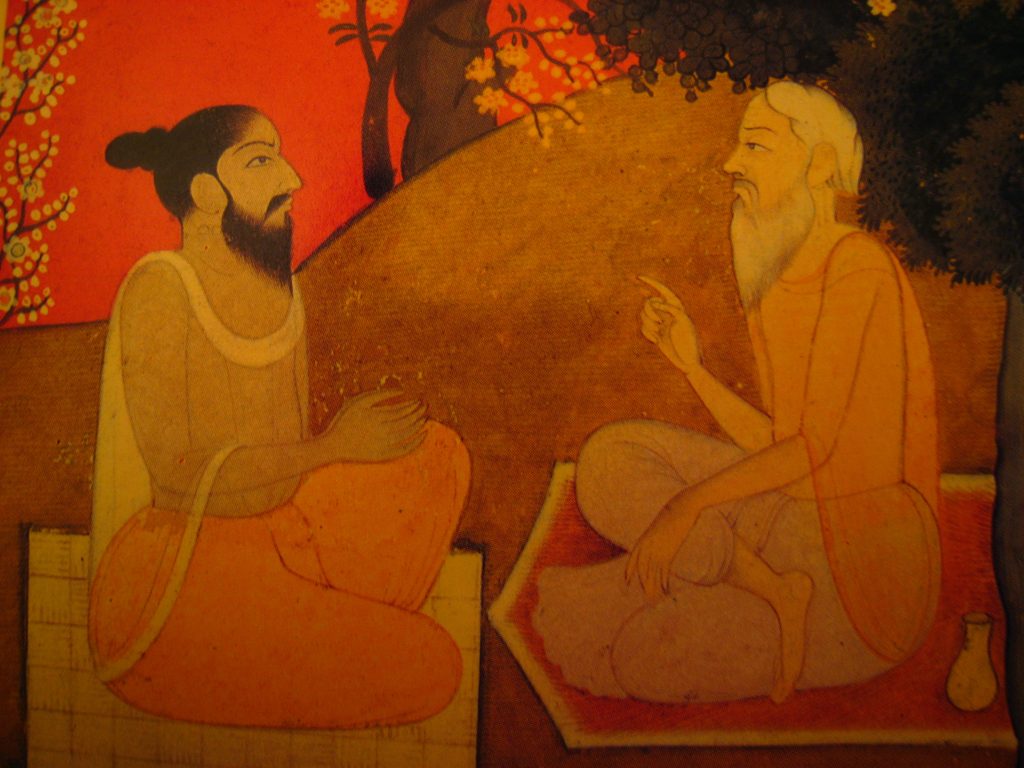The earliest form of Hindu tradition occurred during the Vedic period in Indian history.1 The Upanishads, works of philosophical thought, were a major contribution to the development of Hinduism, taking place long after the Aryan migrations to the Indus and Ganges River valleys and their subsequent interaction with the Dravidian inhabitants. Although Hinduism has no established founder, it is one of the first forms of religious practice, dating back to at least 1500 B.C.E., making it one of the world’s most important and oldest world religions.

The word Hindu is derived from shindhu, the ancient name for the Indus River, where the Aryans are supposed to have first established themselves. Therefore, the name Hinduism could have been influenced by the geographic location of the Aryans, the first to practice Hindu philosophical thought. Early Indo-European migrations, starting around 1500 B.C.E., led the Aryans to enter India and settle in the Punjab region of the Indus River Valley. There they met Dravidians, an already established people, descendants of the earlier Harappan civilization. Although the Aryans were in constant conflict with the Dravidians, and among themselves as well, the Aryans learned agricultural techniques and possibly belief systems from the Dravidians. Eventually, these two groups merged into one culture, combining ideas from the Dravidians with ritual practices from the four Vedas of the Aryans, forming the foundations of Hinduism.
During the Vedic Age, from roughly 1500 to 500 B.C.E., Aryan beliefs were contained in the four Vedas, the oldest of which was the Rig Veda, which mentions their chief deity Indra. He was a violent god, leader of battles and the god of war. Aryan beliefs included sacrifices to other gods too, such as the gods of sun, sky, moon, fire, health, and disease. The purpose of their sacrifices was to ensure victory in wars and military success. Ethics remained a minor aspect of religious practice during the Vedic Age and in the Aryan religion. The beginnings of Hinduism occurred with a popular dissatisfaction with the practice of sacrifices. Individuals sought after a more intimate and meaningful relationship with their gods.2

Along the Ganges river valley, around 800 B.C.E., many individuals began to contemplate the deeper spiritual understanding of the Vedas. Many of these thinkers attracted disciples, and while studying the practices established by the orally transmitted works and characteristics of the Vedas, the teachings of these individuals became the collected writings known as the Upanishads.
Wisdom and knowledge was achieved with the Upanishads in the years between 800-400 B.C.E. Throughout these works, the principle of Brahman, the universal and eternal soul, is explained. In an excerpt from the Katha Upanishad, Brahman is shown to be the Creator:
The all-knowing Self was never born, Nor will it die. Beyond cause and effect, This Self is eternal and immutable. When the body dies, the Self does not die.” —Katha Upanishad
Dravidians had believed in a form of reincarnation, which became one of the main concepts within Hinduism. It is the belief that souls of individuals, or one’s Atman, is actually of the same substance as the universal soul, Brahman. The idea of Atman can be see in the following excerpt from the Katha Upanishad:
There are two selves, the separate ego and the indivisible Atman. When One rises above I and me and mine, the Atman is revealed as one’s real Self. —Katha Upanishad
The Atman seeks to reunite with Brahman, but is hindered from merging with Brahman through ignorance, requiring multiple cycles of reincarnation, or samsara, in order to come to the understanding that one’s Atman is eternal with the Self or Brahman. This learning process is based on the practice of karma, which is rewarded by practices of good deeds, self-control, honesty, and charity while avoiding greed and envy. The ultimate goal was moksha, which was the final release from the cycle of samsara with the merging of one’s Atman with Brahman. The following excerpt in the Kena Upanishad shows the possible merge of the individual soul with Brahman:
Those who realize Brahman shall conquer All evil and attain the supreme state. Truly they shall attain the supreme state!” —Kena Upanishad
Moksha, the dreamless sleep that came with permanent liberation of human pain and suffering, was thought to be achieved through meditation and asceticism. This is the practice of living a simple life and denying all worldly pleasures.3
Today, Hinduism is the world’s third largest religion after Christianity and Islam.4 The Indian efforts to achieve understanding of the world through nature and philosophical thought served as a bridge to the development of Hinduism from the Vedic Age. The Upanishads, through the concepts of Brahman, Atman, samsara, karma and moksha, allowed for a new beginning in society’s understanding of the spiritual world.
- Ancient History Encyclopedia, (2009-2016), s.v. “Religion Timeline.” ↵
- Jerry H. Bentley, Herbert F. Ziegler, Traditions and Encounters: A Global Perspective on the Past Volume 1: From the Beginning to 1500 (New York, NY: McGraw-Hill, 2011), 76-78. ↵
- Jerry H. Bentley, Herbert F. Ziegler, Traditions and Encounters: A Global Perspective on the Past Volume 1: From the Beginning to 1500 (New York, NY: McGraw-Hill, 2011), 80-82. ↵
- Religious Tolerance, December 2015, s.v. “Religions of the world: Numbers of adherents of major religions, their geographical distribution, date founded, and sacred texts,” by B.A. Robinson. ↵



37 comments
Ana Barrientos
I really enjoyed reading this article, it was very interesting and it is very well researched. Reading about how Hinduism was created was actually very fascinating and I had no idea that they had sacrifices. I’ve heard of reincarnation before but I never knew about Atman and Brahman. Atman is trying to merge with Brahman but you can’t merge with Atman if you are envious and all in all aren’t a good person. I found that part super intriguing. Overall, I feel like I have better knowledge about Hinduism.
Samuel Vega
After reading this article I have a better understanding of the origins and history of Hinduism. I learned of the Indian’s desire to better understand the world through nature and how there are ties to the spiritual world. I found the discussion on reincarnation and the reuniting of The Atman with Brahman interesting and could see how the journey to understand one’s self would be difficult to achieve.
Carlos Hinojosa
I never really knew or understood the origin of Hinduism but this article did a wonderful job explaining it so that was really helpful. I knew about the Vedic Age but I never really understood what it meant until you explained it better in this article. Either way this article was extremely well made and did a good job explaining it. Great article and a really good read.
Roberto Soriano
I think this article does a great job of explaining some of the pillars and backstory of Hinduism, this is the first time I read about this which I find fascinating this also includes the idea of reincarnation and karma, to this day I think a lot of people know about this ideas without even having a thorough understanding of religion or Hinduism itself. It is also interesting to point out how a group of people who started to think more about their connection with their gods lead to what we now know as Hinduism.
Davis Nickle
This article does a fantastic job at detailing the basic rise and evolution of early Hinduism. It also does a great job at explaining the belief system of the Hindu religion while using the terms that are use by its followers. It really is incredible how much the Upanishads did to improve upon and change the Hindu religion, and this article does a great job at showing what those improvements were.
Aaron Sandoval
This article was really well done and was very insightful. I had no idea about how Hinduism came to be, I have never really been interested in religion, and this article did a good job of explaining how Hinduism came to be, and how it became the third largest religion in the world. I think it is really cool that Hinduism was in a sense of fusion of two different religious concepts that came together well, and has spread and is still followed by people all over the world.
Christopher Hohman
Nice article. We can definitely thank Hinduism for two very interesting concepts. Karma and Reincarnation. The fact that the Hindus came up with Karma is so cool because today so many people believe in Karma at least ironically they do. It is such a widespread word and belief and it is cool to think that Hinduism brought us that. Also reincarnation is very cool too. I think the idea that you are reborn after you die into a new life is just an awesome possibility
Steven Hale
I am surprised to learn that Hinduism does not have a founding figure. Most other major religions devote a significant part of their holy text to the life of lives of the religion’s key influencers. Perhaps Hinduism’s emphasis on selflessness comes from the fact that this religion does not have one or more humans to revolve around. I know some religions rely on similar stories-such as a great flood-but this article is the first I have heard of two cultures merging their belief systems.
Rajananthini
We all know Rajagopalachari as a patriot, astute politician, thinker but he is also a good writer and out of his works Ramayana & Mahabharata have been very popular. He also penned Upanishads in which he have clearly explained the holy scriptures of the world, displays the most scientific spirit in connection with spiritual enquiry. You can enjoy this book at iMusti.
Regina De La Parra
This article was a very useful reading because of all that it explains about Hinduism and its beginnings because growing at a Catholic household, many times we make belittle other religions. I have known Hinduism as a very important religion but sometimes have heard the remarks that it is a “primitive” and often “uncivilized” religion, when it is not like that at all. I really liked reading this article a lot because it allowed me to open my eyes to this truth. Great job Priscilla!